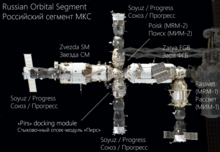Poisk
| Poisk | ||||||||||||||||||||||
|---|---|---|---|---|---|---|---|---|---|---|---|---|---|---|---|---|---|---|---|---|---|---|
 Poisk, still with Progress service module, docked at Zvezda
|
||||||||||||||||||||||
| Space station: | International space station | |||||||||||||||||||||
| Start date: | November 10, 2009 | |||||||||||||||||||||
| Launcher: | Soyuz | |||||||||||||||||||||
| Coupling: | November 12, 2009 | |||||||||||||||||||||
| Dimensions: | 3 t | |||||||||||||||||||||
| Length: | 4.91 m | |||||||||||||||||||||
| Diameter: | 2.55 m | |||||||||||||||||||||
| Volume: | 12.5 m³ | |||||||||||||||||||||
| Adjacent modules | ||||||||||||||||||||||
|
||||||||||||||||||||||
Poisk ( Russian Поиск for search ) formerly Mini-Research Module 2 , MRM-2 ( Russian Малый исследовательский модуль-2 (МИМ-2) MIM-2 , Mini-Research Module 2 ) is a module of the International Space Station . It is essentially the previously canceled Russian Docking Compartment 2 (DC2) and at the zenith port of Zvezda docked. The launch took place as part of a modified Progress transporter with a Soyuz rocket. Poisk serves as a coupling module for Soyuz and Progress spaceships and as an air lock for exits . But it is also used for external scientific experiments, hence the original name. The expansion of the station made it necessary to use it as a coupling adapter, as the doubling of the ISS crew has always meant two Soyuz spaceships have been at the ISS since May 2009. The module is the replacement for Pirs (DC1), which is to be replaced by the Nauka module.
Poisk was launched on November 10, 2009 at 14:22 UTC and docked at the Zvezda module on November 12 at 15:41 UTC. On December 8, 2009 at 0:16 UTC, the service module that was no longer required was disconnected from Poisk and then brought to a controlled crash. This was the first time that four Russian coupling adapters were available on the ISS.
Poisk has two coupling nozzles: an active coupling nozzle of the type "SSWP-M 8000" at the end of the module, which is docked at Zvezda, and a passive coupling nozzle of the type "SSWP G4000" at the opposite end, where spaceships can dock. Poisk acts as an adapter, so to speak, and thus offers a fourth option for coupling Soyuz spaceships and Progress freighters in addition to Pirs , Sarja- Nadir (now Rasswet ) and the rear docking socket of the Zvezda module . Before Poisk was docked, only three spacecraft with Russian docking adapters could be docked to the station.
Poisk is based on the Progress-M space transporter, on whose drive block or service module the actual module is placed, which is similar to the Pirs module . It is 4.91 meters long, has a maximum diameter of 2.55 m, an internal volume of 12.5 cubic meters and weighs about three tons. It brought 750 kg of supplies to the ISS and has two inward-opening hatches with a diameter of one meter, which serve to close the airlock. The module with Strela-1 currently has its own crane arm to support research and repair measures.
Web links
Individual evidence
- ↑ Docking Compartment-1 and 2. russianspaceweb.com, accessed on March 26, 2009 (English).
- ↑ Chris Bergin: Russian module launches via Soyuz for Thursday ISS docking. NASASpaceflight.com, November 9, 2009, accessed November 11, 2009 .
- ^ Stephen Clark: Poisk module adds room to International Space Station. spaceflightnow.com, November 12, 2009, accessed November 12, 2009 .
- ↑ ISS On-Orbit Status 08/12/09. NASA, December 8, 2009, accessed December 9, 2009 .
- ↑ FliegerRevue January 2010, p. 39, New space station module Poisk


